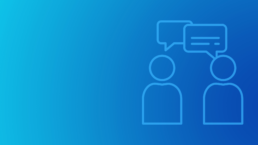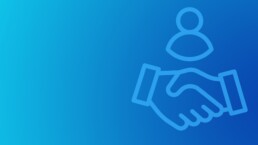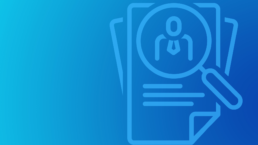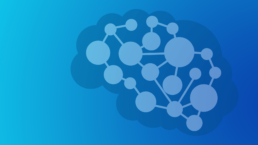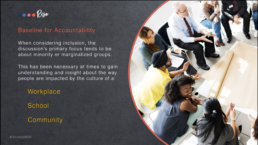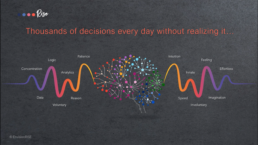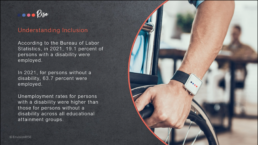Employee Development with Impact
Employee Development with Impact
By Staci Hegarty, M.Ed., COO
Employees want and expect their employers to offer timely and relevant career development training. The percentage with the expectation varies based on several factors, including age. More than 90% of the youngest workers, Gen Z, rank learning and development as a priority for them when considering accepting a new job or leaving their current job. Most employees say that they are unlikely to leave an organization that has invested time, effort, and money into their professional development.
The days of learning everything you need to know for your career in college are gone. Studies indicate that the information learned in college becomes obsolete within about five years of graduation. This puts the burden for continued learning squarely on the shoulders of employers. Yet more than 50% of CEOs do not believe that learning and development efforts are successful. Where is the disconnect?
Too often employers struggle to find ways to connect relevant training to their workforce. While adults tend to prefer self-paced learning opportunities, they also want that training to be immediately useful at their job. If employees do not see how the training will help them NOW they will not invest time and effort on learning the material. K-12 education has been emphasizing “diversified learning” for years, employers should adopt a similar mindset. Giving employees what they need to continue to grow increases equity in the workplace.

It is critical that employees be given the opportunity to assess their current skill set to determine what is needed. This can be done in several ways, from formal skills assessments to self-assessments to 360 assessments, all of these options provide, Take the time to review the results with the employee to ensure that everyone is in agreement.
Once the needs are identified, it is time to figure out how to meet those needs. Again, there are many options. It may be as simple as pairing the employee with another employee who already possesses the skill or creating a formal mentoring relationship if the developmental goal is more than a specific task or two, such as preparing an employee for a management or leadership role. There may be classes that are available or even providing tuition assistance for an employee to attain a degree or certification.
While diversified learning is important, there is also a need for enterprise-wide learning. This is the kind of training that benefits everyone, such as active listening, effective communication, and conflict de-escalation. It may also include required compliance training that helps to keep companies up to date with regulators and legal entities.Regardless of the kind of development offered, leaders must be willing to benchmark the current state and monitor progress toward the future state, not only of the employee but of the organization. This can be done through KPIs and performance appraisals. If the company has decided to focus on employee growth and development, it is necessary to review and revise the
tools that are used to track progress. Envision RISE can provide the roadmap and tools for organizations to build training and development programs that engage employees in relevant learning. For more information, contact us at info@envisionrise.com.
Contact Envision RISE for more information about how we can assist in building and maintaining efficient and ethical hiring practices and processes.
Our evolutionary platform helps companies create a powerful integration and understanding of the relationship between the organization and the workforce. Envision RISE empowers your people to drive continual change and innovation through effective strategy and transformation.
The First Six Months
The First Six Months
By Staci Hegarty, M.Ed., COO
Conventional wisdom encourages people to stick with a new job for at least six months before deciding to move on. While we should be taking care of our employees all the time, this is especially important during the first six months. Since we thought they were good enough to hire, we have a vested interest in their success with the organization. It can cost up to two times of an employee’s annual salary to replace them.
The most obvious time that an employee is being onboarded is during the first few days of employment. If your organization uses intentional onboarding, a new employee should be starting to feel more comfortable with their role and with the organization as a whole. They have likely started to engage with their tasks as well as with their supervisor and colleagues. It may be tempting to assume that all is well and assume the employee will raise their hand and ask for help if the need it. Do not give in to that temptation! A new employee wants to impress their new employer with their proficiency and skill, yet they may not know enough about functioning within the organization to even know what questions to ask.

The First 30 Days
After training is completed, it may seem that the employee knows what they are doing and can be released to do the job for which they were hired. Rather than letting the new employee “go and do”, this should be a time of daily check-ins, perhaps more if needed. This will be a month of Firsts. First time using the CRM tool. First team meeting. First weekly report. First submission of payroll. We don’t let teen drivers take a driver’s education course, take a few turns around a parking lot and then put them on the freeway during rush hour. We sit in the passenger’s seat and offer support and direction as they work their way up from the parking lot to side streets to main streets to the freeway. As experienced drivers, we take a lot of instinct and knowledge for granted and cannot assume that a new driver can assess an ever-changing situation with the same speed and competence we do. Your new employee is trying to take in a lot of information and needs close supervision to ensure that small mistakes don’t become catastrophic.
Use this time for real-time training. The show-then-do method works well for this. Show the employee how to do the task then watch them do it. Most people learn best by watching someone do it then trying it themselves with the guidance of an experienced teacher. This is also the time to set the cadence of the workplace. Anything that is a recurring event, such as staff meetings or reports should be on the employee’s calendar now.
Schedule a formal weekly check-in meeting. This is not a time for the supervisor to do all the talking, this a chance for the new employee to ask questions and clarify tasks, with the opportunity to share how they are feeling about their new workplace. Take some time to get to know the new employee, make sure they are making connections with their colleagues.
The First 60 Days
By now your new employee likely has mastered their basic duties. Now is when the one-offs or unusual situations may come up. To continue with the driving metaphor, they are gaining the confidence to drive on busier roads with less direction, but they are not ready to go it alone. A supervisor may have noticed gaps in training or tasks that the employee struggles with doing on their own. Continue to offer support and training, with constructive feedback on areas that need refinement.
You may need less frequent check-ins, going from daily to perhaps three times a week. Now is the time to bring in other employees who can assist. This not only gives the new employee more training and support, but it allows more tenured employees an opportunity to grow their own skill set in leadership.
Continue with the weekly formal check-in meetings. You will notice a decline in questions about specific tasks and an increase in more culture-related questions. The new employee is probably starting to discover that the way they were trained may not completely line up with the way work is completed in reality. They are starting to learn who the go-to people are, which may not be reflective of the process and procedure manual or the organizational chart.
The First 90 Days
The good news is your new employee is ready to drive on the freeway! The bad news is, they may be overly confident in their skills and start to make new mistakes that weren’t prevalent before. Continue to monitor their work closely and step in when needed. They are probably doing a good job on 75% of their tasks, but they still need positive reinforcement to continue their growth.
This is also the time when employees stop feeling new and start feeling awkward about asking questions about things they think they should already know. They may be proficient at weekly reports but have never done the quarterly report. They may now be able to use PTO and need to understand the process for requestion a sick or vacation day. Keep up the weekly meetings.
You may also start to notice their personality starting to come through. When we are in a new environment we tend to be on our best behavior. If you are noticing habits or traits that are not contributing in a positive way, now is the time to address it. For example, you may start to notice of trend of tardiness. It’s time to get curious and ask about what is going on. You may discover that the employee’s car is in the shop and they are taking the bus now. Perhaps a temporary schedule change would help. No matter the reason for the tardiness, it is good to be clear about expectations.
The Next Three Months
Your new employee should be settling in well now. They may occasionally need more training or direction but should be generally be functioning as expected in their role. The company has now invested a great deal of time, energy, and money in their onboarding. Now it less about tasks and more about culture. You may notice that your no-longer-brand-new employee has found a group of work friends. Depending on who those friends are, you may notice a downturn in their productivity or attitude. The shine of the New Job has worn off. Be mindful that comfort may become complacency. It may be time to pair the employee with a high performer with a positive outlook on the organization to help combat any negativity they may be experiencing. It has been said that we are the average of the five people we spend the most time with. If your goal is an engaged workforce, help your employees find engaged colleagues to encourage them. Your workplace culture and employee turnover may depend on it!
Envision RISE can help your organization formulate a six-month plan to hep newcomers not only learn their new job but to become valued members of the team. Contact us at info@envisionrise.com for more information.
Contact Envision RISE for more information about how we can assist in building and maintaining efficient and ethical hiring practices and processes.
Our evolutionary platform helps companies create a powerful integration and understanding of the relationship between the organization and the workforce. Envision RISE empowers your people to drive continual change and innovation through effective strategy and transformation.
Intentional Onboarding
Intentional Onboarding
By Staci Hegarty, M.Ed., COO
Starting a new job brings a range of emotions, from joy to apprehension to anxiety. The first day of a new job sets the tone for what an employee can expect from the organization. Many times, the onboarding process has been in place for years, with additions being made as needed. During the early days of the pandemic in 2020, companies were forced to quickly change the way they worked, including how new employees were brought in. Technology can be very useful as a support tool for onboarding, but it should not be the main character in the onboarding process. Even remote employees need some human interaction, especially during the onboarding process.
Onboarding begins where hiring ends. The offer letter is the first step in the onboarding experience. It should be provided in a timely fashion and include all the relevant information, such as start date, salary, work location, and Next Steps. Most people will not resign from their current job until they have the offer letter, any delay not only causes a delay in starting the new role, but it may also cause stress for the new employee before they have even started!
When possible, have the new employee complete most paperwork before the first day. Even if it is not 100% complete, it will allow everyone to focus on connecting with each other instead of filling out forms. Your company may have protocols for badges, logins, keys, and parking passes that are contingent upon new hire paperwork. Doing this early will mean that the new employee has everything they need on Day One. This is especially helpful if you are onboarding multiple people on the same day.
Provide an agenda for the first day, or first few days. Some things never really change, the first day of school was stressful for most of us as children. The first day of a new job is stressful for the same reasons. Will I get lost? Will I know enough? Will I be alone at lunch? An agenda that introduces the new employee to their new boss, new colleagues, other departments, and organizational leaders will help alleviate some nervousness. Conduct a tour of the facility early the first day to help employees build a mental picture of what their environment will be like. The sooner a new employee has the basics, the sooner they can start focusing on the role-based tasks.

Onboarding does not end after the first few days of employment. It takes time for people to learn their role, how they fit in with the big picture, and what the culture of the organization demands from people. Keeping new employees close for the initial 90 days will help build confidence, help managers to assess training needs, and allows new employees to fail in a way that will not be catastrophic. Even people with experience in the role need to time to adapt and adjust to a new company, with different systems and different expectations.
For some people, asking questions and speaking up comes easily. For others, it can be difficult to seek answers without feeling exposed or insecure. A thorough onboarding process that continues beyond the first week will allow new employees, regardless of confidence or disposition, the opportunity to learn while also becoming integrated into the culture of the organization. When surveyed, 94% of respondents indicated that a feeling of belonging is critical to their opinion of their employer. Don’t make new employees work too hard to belong, build a process that fosters belonging and inclusion from the beginning.
Contact Envision RISE for more information about how we can assist in building and maintaining efficient and ethical hiring practices and processes.
Our evolutionary platform helps companies create a powerful integration and understanding of the relationship between the organization and the workforce. Envision RISE empowers your people to drive continual change and innovation through effective strategy and transformation.
Ethical Hiring Practices
Ethical Hiring Practices: Building a Robust Workforce in the Modern Employment Era
By Staci Hegarty, M.Ed., COO
The job vacancy rate in the US is currently 5.4%, higher than the average of 3.55%. Unemployment is at a nearly 50 year low, at 3.7%, By 2030, all Baby Boomers will have reached the traditional retirement age of 65, leaving more job vacancies. Organizations are struggling to fill existing vacancies, especially in healthcare and technology https://www.bls.gov/ooh/most-new-jobs.htm. To fill critical roles, it may be tempting to rush through the hiring process or even cut corners to ensure adequate staffing levels.
Ethical hiring practices not only lead to increased job performance, but also to greater employee satisfaction and retention. Every company wants to believe that they are honest and transparent when hiring and onboarding a new employee, yet some employees feel that they were not provided with all the information they needed to make a good decision about accepting an offer.
Transparency
It starts with transparency. Over time, job descriptions and the actual job function may become very different. It is necessary to update job descriptions regularly, with a thorough evaluation prior to posting the job vacancy. If the role has been filled by a long-term employee, it is entirely possible that the former employee was doing a lot of tasks that are not outlined in the job description. Sometimes companies may determine that the role should now be split into two separate jobs, rather than trying to find someone new with a broader skill set. Letting a potential applicant know all the expectations will save time and frustration for everyone. Resist the urge to let the sentence “Miscellaneous duties as assigned” do too much heavy lifting in your job descriptions.
Recognize who is “missing from the table.” There is a lot of discussion now about “hiring quotas for diversity.” This is not the same thing as mindful hiring. Recognizing that certain voices are missing from your organization should not result in a quota mindset, but it may encourage your company to expand or change current recruiting practices to increase the diversity of the candidate pool.
Candidate Sourcing
Be proactive in your sourcing of candidates. It is tempting to let technology do the initial screening, and many organizations assume that AI will filter out any human biases. Research shows that because AI uses human input, those biases can remain. Decide at what point in the process humans will be involved in reviewing resumes. If you are looking for greater diversity, it may take a more hands-on effort that requires humans to be involved from the beginning.
Determine the urgency of each hire. Some roles play a more integral part in the day-to-day operations than others. Replacing a salesperson on a team of 50 may not have the same urgency as replacing a staff account on a team of three. This will help your talent acquisition department know where to focus their energies or even bring in an outside recruiting agency.

The Interview Process
Formalize your interview process. Use a standard set of questions for every candidate. Consider forming an interview panel that consists of people from different departments and roles. Make the panel as diverse as possible, not just in race, gender, and age, but also in time with company. Each person will bring their own lived experience to the interview, which will lead to greater insights for both the company and the candidate.
Share your timeline and keep the candidate updated on their status. Whether you are looking to hire in the next month or the next three months, it’s important to let the candidate know what to expect. Even if your projected start date is a few months out, that does not necessarily mean you will lose the candidate if you keep them updated on their status. If you tell the candidate you will be making a decision quickly, give them a date to expect a decision. Do not “ghost” a candidate if you do not plan to proceed with them! Most people would prefer an honest answer so that they can move on with other options. Honesty says a lot about your organization, even if the candidate is disappointed in the outcome of the interview.
Your company’s reputation is more than your marketing campaign. Your hiring process tells potential future employees, and possibly future customers, a lot about your organization. Honesty, transparency, and consistent communication are markers of integrity. A candidate may not get the job, but they will still tell people about the good experience they had during the process. Word of mouth can go a long way in building a reputation outside of your branding.
Contact Envision RISE for more information about how we can assist in building and maintaining efficient and ethical hiring practices and processes.
Our evolutionary platform helps companies create a powerful integration and understanding of the relationship between the organization and the workforce. Envision RISE empowers your people to drive continual change and innovation through effective strategy and transformation.
Workforce Training: What is it and Why Does it Matter?
Workforce Training: What is it and Why Does it Matter?
Sara Skidmore, Envision RISE
Change and growth are a part of every organization. That is especially true today, where young employees are changing jobs more than their predecessors ever did and workforces are becoming increasingly more diverse. So how do organizations adapt to these changes and maintain a competitive advantage? The answer lies in well-designed and ongoing workforce training.
The Benefits of Workforce Training
There are numerous benefits of making workforce training an ongoing part of your organizational strategy. Below are just a few.
Talent Acquisition
Self-improvement is an important part of a balanced and healthy lifestyle. We all need to feel that we are being challenged and reaching our potential. For most people, personal and professional development are distinct but intertwined experiences. When we are given opportunities for professional development, we usually grow personally as well.
Today’s employees are seeking opportunities for personal and professional growth. Acquiring new skills gives employees a sense of accomplishment and makes them feel confident in their roles. This, in turn, increases job satisfaction. Offering well-designed and ongoing training opportunities makes organizations attractive to job-seekers, giving them a distinct competitive advantage when it comes to talent acquisition.
Enhance Team Productivity and Collaboration
Among recent changes in workforce dynamics is an increased use of teams. The vast majority of employees today work in teams. Working in teams comes with numerous benefits, but it is not always easy. Team members must learn to communicate effectively, work with people who differ drastically from themselves, provide and receive feedback, and collaborate with one another to bolster creativity and innovation. Consistent workforce training can help.
Training benefits teams in several ways. It helps employees be on the same page when it comes to organizational policies, procedures, and strategic goals. If done correctly, training can improve workplace culture and climate and help build employee relationships. As a result, teams are able to communicate more effectively and resolve conflict. They become more engaged and collaborative. In other words, well-trained teams are effective teams.
Succession Planning
Organizations that don’t plan ahead suffer. An important part of strategic planning is identifying strategic goals and the roles that are needed to accomplish those goals. Effective succession planning ensures those roles will always be filled by competent employees. Preparing employees to have the knowledge, skills, and abilities to fill leadership roles should be an ongoing process in every organization. Workforce development and training programs equip current employees with knowledge and skills needed for successful leadership.
Sustained Organizational Change
Organizational change doesn’t happen overnight. A structured and consistent approach to change is more likely to have lasting results.
Workforce training is a way to get everyone – employees, teams, and managers – involved in the change process. It educates employees about the importance of the change, their role in making the change happen, and it helps them understand the organization’s vision. When employees understand these things, they become more engaged in the change process. An engaged workforce is more likely to bring about lasting change.
Implementing Ongoing Training in Your Organization
Organizational problems are inevitable. Don’t assume your workforce is already equipped with the knowledge needed to manage these problems. Get ahead of the problem. Prepare your workforce to face problems head-on by implementing a well-designed and ongoing training program.
Hiring workforce development professionals is a good place to start. Workforce development professionals work with organizations to develop organizational goals and objectives and come up with tailored training plans to help accomplish those goals. They can help prepare workforces to grow professionally, work effectively on teams, manage problems, and acquire leadership potential. Contact Envision RISE for more information on how to help your organization implement training programs that result in lasting change. Visit our Training page to learn about the RISE Academy, which makes learning accessible and impactful by bringing together exclusive industry certifications and accredited courseware under one innovative platform with self-assessments, self-reflection exercises, course workbooks, and training progress report cards.
References:
https://www.cbsnews.com/news/workplace-diversity-retention-recruitment-race-ethnicity-age/
https://emeritus.org/blog/benefits-of-team-training-in-the-workplace/
https://www.indeed.com/career-advice/career-development/change-management-training
Beyond Awareness: Harnessing the Benefits of a Neurodiverse Workforce
Beyond Awareness: Harnessing the Benefits of a Neurodiverse Workforce
Sara Skidmore, Envision RISE
American organizations are facing unprecedented changes in employee demographics. Within these demographic changes is an increase in employees with neurodivergent conditions, such as autism spectrum disorder (ASD), attention deficit hyperactivity disorder (ADHD), dyslexia, social anxiety, and others. Given that 15-20% of individuals have neurodivergent conditions, it should come as no surprise that organizations are becoming increasingly more neurodiverse.
Benefits of Neurodiversity
There are numerous organizational benefits of a neurodiverse workforce. One benefit is that it drives innovation. From Bill Gates and Steve Jobs to Emma Watson and Tim Burton, some of the world’s best innovators have neurodivergent conditions. Having a workforce with diverse ways of processing information reduces groupthink and drives innovation, giving neurodiverse organizations a competitive advantage over their competitors.
Another benefit is that neurodiverse-inclusive policies and practices can boost company culture. In a Microsoft study of 31,000 employees in 31 countries, employees rated having a “positive culture” as one of the most important factors they look for in a job. Organizations that want to attract and retain top talent must foster cultures of inclusivity for all employees, including those in the neurodivergent community.
Promoting Neurodiverse Inclusiveness
So, how can you promote inclusiveness in your workplace so that you can harness the benefits of a neurodiverse workforce? Below are a few ways to ensure neurodiversity initiatives are a key part of your organization’s diversity, equity, and inclusion practices.
- Begin with examining current neurodiverse inclusivity practices. Understanding your current baseline can guide neurodiversity objectives and goals.
- Consider nontraditional selection practices. For example, non-conventional interview settings and specific (as opposed to general) cognitive ability tests can help organizations identify qualified candidates with neurodiverse conditions.
- Incorporate accommodations for neurodiverse individuals. These can include flexible work hours, breaks between meetings, and areas with reduced noise and lighting.
- Hold training sessions that help managers and employees understand their role in promoting inclusivity.
Today’s workforce is more diverse than ever. Understanding how to harness the benefits of a diverse workforce is a necessary component of thriving organizations. Prioritizing neurodiversity is just one way organizations can harness those benefits and gain a competitive advantage. Contact Envision RISE for information on how to make neurodiversity initiatives a key part of your DEI practices.
The Workforce Beyond Boomers
The Workforce Beyond Baby Boomers
Staci Hegarty, M.Ed, VP of Equity and Inclusion
2030 is the year all Baby Boomers (born 1946-1964) will be at or above the traditional retirement age of 65. Although many Boomers work well past that age, there will be more open roles within organizations that cannot be filled by the next generation of workers. Combine this with the Great Resignation, employers are finding themselves in the difficult position of not being able to find enough qualified workers.
What Does the Future of the Workforce Look Like?
Organizations are not only losing the employee, they are also losing historical knowledge and the skillsets that come with time spent on the job. On average, Boomers are most likely to spend more years with the same employer than the other generations. The average Boomer has a workplace tenure of over eight years, with several studies indicating that nearly 40% have been with their employer for 20+ years. Gen X (born 1965-1979) averages about 5 years, while Millenials (born 1980-1994) and Gen Z (born 1995-2012) both average less than three years.
The younger generations are quick to leave an organization that does not value their time, talents, and insights, and with so many open roles, they are able to find new opportunities relatively quickly. Employee attrition can destroy a company by derailing the strategic plan, stifling innovation, and driving up costs related to human resources and recruiting. We are already in a hiring crisis and employers must take tangible and impactful action to retain and promote the workers they already have.
How Do We Support the Next Generations?
The old mindset of employee retention no longer works. A fair salary is an obvious requirement to attract a retain employees, but that alone will not be enough to prevent an employee from leaving. The culture of the company is the most important thing to workers. Job security, work/life balance, connections with coworkers and flexibility – in not only work schedule but in workplace (home versus in-office) – are the top four drivers of employee satisfaction. Organizational Change Management (OCM) in partnership with Diversity, Equity, and Inclusion (DE&I) work will allow companies to transform the existing workplace culture from “good enough for now” to dynamic, empowered, and innovative.
Envision RISE offers a comprehensive approach to help companies build a dynamic and empowered workplace culture that is prepared and adaptable. Through surveys, focus groups, executive alignment, and policy review, Envision RISE can help companies understand their employees’ sentiment, identify areas of improvement, and develop a roadmap for continual improvement. This approach is crucial for creating a workplace culture that not only retains employees but also drives innovation and growth.
Contact us to get started. Listen in to the most recent Envision RISE Podcast featuring Martine Kalaw, founder of Martine Kalaw Enterprises and author of “ABCs of Diversity,” as we discuss the generational changes actively happening and how they are reshaping the future of the workforce.

Unlocking Employee Retention: Strategies for the Challenging Labor Market
Unlocking Employee Retention: Strategies for the Challenging Labor Market
Staci Hegarty, M.Ed, VP of Equity and Inclusion
In the United States, a common complaint is that “no one wants to work,” even though we are currently experiencing a period of the lowest unemployment in the past 50 years. This, coupled with the fact that all Baby Boomers are rapidly reaching traditional retirement age by the year 2030, means we are in a difficult position of having more open roles than we have available workers.
In this environment, employee retention has become a top priority for companies, particularly amid “The Great Resignation.” Envision RISE course RISE-08 “Transparent Development and Retention Practices” states, “Healthy, high-performing organizations have the policies and procedures in place to uncover problems before it costs them high-potential employees. Once employees start resigning, the reputation of the company is at risk.”
Retaining Current Talent
Rather than competing for qualified candidates, organizations are taking steps to retain the ones they already have. The days of a steady paycheck being enough are long gone. Employees now seek fair and equitable pay, benefits that meet their needs, and a workplace culture that values what each person brings to the job, as well as inclusion and a sense of belonging.
Unfortunately, many employers dismiss these desires as passing fads or entitlement. However, research indicates that employees who feel a greater sense of belonging and inclusion at work report a significantly higher Employer Net Promoter Score (eNPS), which measures the likelihood that a current employee would recommend a company as a great place to work. This metric can provide insights into company culture, predict turnover, and gauge overall employee engagement.
How to Measure Inclusion and Belonging
Here are a few ways to start measuring inclusion and belonging at your organization:
- Start by examining who is in your workforce. Who gets hired and who stays?
- Provide thoughtful exit interviews. What do they tell you?
- Consider using “Stay Interviews.” Stay Interviews identify trends that could be contributing to employee turnover. By prioritizing employee retention and cultivating an inclusive workplace culture, companies can thrive in this challenging labor market.
Overall, companies must invest in employee retention if they want to remain competitive and profitable. A steady paycheck may have been enough in the past, but today’s employees seek much more than that. Fair pay, appropriate benefits, and inclusive workplace culture are essential components to successful employee retention. Ultimately, it’s up to employers to earn the loyalty of their current employees by creating a work environment that meets employee expectations and shares in the companies’ successes. Ensuring that all employees feel valued, respected, and part of a greater whole will help any organization stay competitive. For guidance on how best to meet these goals, contact Envision RISE for employee retention services and strategies tailored to your needs.
Travis Shumake to Honor Father's Upset Win with Tribute Car at Auto Club Finals
TRAVIS SHUMAKE TO HONOR FATHER’S UPSET WIN WITH TRIBUTE CAR AT AUTO CLUB FINALS
NEW YORK, NY (November 7, 2022) — 40 years after his father Tripp’s upset Funny Car win at the 1982 World Finals, Travis Shumake will return to southern California with the same goal. In 1982, the elder Shumake was brought in by Funny Car legend Billy Meyer as a “blocker” to defeat championship contenders Don Prudhomme & Frank Hawley. The single-race deal and Cinderella story ended with Shumake in the finals against Kenny Bernstein after taking out both Hawley and Prudhomme earlier in the day at what would be the last World Finals held at the famed Orange County International Raceway. This weekend at the Auto Club NHRA Finals, Shumake wraps up a successful debut season racing the Randy Meyers owned and tuned Top Alcohol Dragster with the support of Envision RISE, an evolutionary platform that utilizes Organizational Change Management (OCM), Human Resource Management (HRM), and Diversity, Equity and Inclusion (DE&I) to create a powerful integration and understanding between organizations and their workforce.
“Our partnership with Travis has created a direct path for us to connect in a unique way with the NHRA fan base and our clients,” said Envision RISE’s founder and CEO, Joseph Anderson. “Travis has been a huge supporter of our mission and has worked hard to demonstrate his commitment to becoming a top NHRA driver and an advocate for opportunity derived from hard work and respect.”
The second-generation driver will be channeling the spirit of his popular father and the surprise success of his 1982 win with a throwback paint scheme, helmet, and crew uniforms.
“I grew up watching a VHS of my dad’s magical day at World Finals. I still watch it. Regularly. I’m just as proud of his other wins and accomplishments like being in both the Cragar Five-Second Club and the 250 MPH Club but having the TV coverage and interviews make this race special. He’s been gone 23 years this Sunday and his finish line interview with Steve Evans is the only place I can go to hear his voice. I get to hear him, see him, and now I’m hoping my own finish line interview with Amanda Busick. Makes the hairs stand up on my neck.”
“I’m not just here to honor my dad, I’m here to win and wouldn’t mind facing off with one of the drivers in the hunt for the championship. We’ve got the car. Between me, Hunter (Green), Fiona (Crisp), and Matt (Sackman), this Randy Meyer “team B” car has been turning on win lights all season long. If the points stayed with the car this beast would be deep in the points battle.
Shumake grabbed a top 3 qualifying spot in Charlotte and posting a career best semi-final finish at historic Maple Grove Raceway where he won the first two rounds on impressive hole shots. This weekend’s Auto Club Finals will be his 4th national event and a chance for the New York City resident to close out his season on a high note and carry momentum into the off-season as he looks to expand his racing schedule in 2023.
“I’m chasing funding for 2023 just like everyone else but am starting to get excited about the future.” Said Shumake. “Right now I’m just enjoying the opportunity to learn from Randy and drive alongside Julie (Naatas). Add all the marketing help I’ve gotten from Megan (Meyer) into that mix, and you quickly realize I’ve been training under the best in the business all season long. I hope bringing big names like Sheetz and Envision Rise into the sport shows folks I am serious, committed, and certainly no flash in the pan.”
Shumake and the Envision RISE Top Alcohol Dragster will be on track twice on Thursday, November 10, running at 1:45 p.m. and 4:30 p.m. and teams will get a final qualifying run Friday at 2 p.m. Saturday will begin Shumake’s quest for victory with the first round of eliminations at 10:15 a.m.
About Envision RISE
Envision RISE was founded as a modern workforce development platform to create a non-divisive integration and understanding of the relationship between the needs of an organization and the requirements of the actual workforce. The platform provides a voice to the individual and a framework critical to long-term business sustainability.
Promoting a Culture of Calm During Chaos
Staci Hegarty, Envision RISE, Vice President of Equity & Inclusion
We are more than two years into the most intense period of change that most of us have ever experienced in the workplace, and for some of us, in our lifetime. After the initial shock, many organizations managed to adapt to life during COVID. Theses adaptations were far from perfect, and we are still working through it and learning from it. There is civil unrest across the US, which will not abate any time soon. The economy is teetering on the brink of recession, with inflation at a 40-year high and gasoline hitting record prices. The “Great Resignation” coupled with low unemployment pushed staffing levels to the breaking point. Many organizations are struggling to find their center. Those that have taken promoting a culture of calm during chaos seriously have been better able to weather the storms.
We are not our best selves right now.
And yet, we have done some of our best change management over the past couple of years. We were so confident in what we believed to be true for so long that we rarely questioned it. When forced to question almost everything, look what we discovered! We can be flexible in our work locations and still get results. We can engage in uncomfortable conversations about topics we were always told were off limits at work, which allows us to learn more about ourselves and our colleagues. The economic issues we experience are not in a vacuum; we are an inextricably connected global economy. Finally, we can demand better from our workplace cultures, or we can find a better workplace.
For those waiting to “return to normal,” I have bad news for you. There is no going back. The last few years exposed many truths about our workplaces and how we are affected by that culture. Crisis shows us our true selves.
Amid chaos, what was the prevailing emotion at your company? Did you find out that your organization is much more fragile than you realized? Or did you uncover innovation and resilience that was just beneath the surface of everyday life?
Understand more about your company by understanding its DNA. Your company’s DNA structures the ecosystem framework. Upon this framework is built the foundation for your culture throughout the employee lifecycle. When the DNA is fragmented, broken, or otherwise unstable, it creates an imbalance that compromises the health of the organization. Unhealthy organizations struggle to overcome the stress of change, especially unexpected change. The RISE Human Resources Management (HRM) DNA analysis helps identify the areas that need attention and strengthening. Combine the HRM DNA analysis with the Envision RISE comprehensive cultural assessment to create an actionable strategic plan for lasting organizational cultural transformation.
